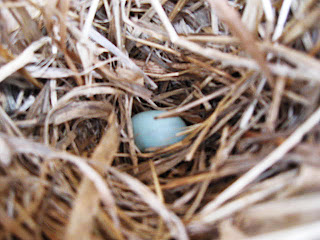April 30
First eggs of the 2013 season!! Pictured above are the first kestrel eggs I have seen this year. I decided that starting today I had to make another swing through and check the inside of every single box in my project, regardless of what I THOUGHT was going on with any one particular box. I have been "missing in action" for the last three days because I had to attend an artists' fair where I was displaying/selling my bird photography. Most readers of this blog are probably not aware that in addition to being a kestrel researcher I am also a professional bird photographer (www.onthewingbirdphotography.com)
Sooooooo......what price did I pay for taking three days off from nestbox monitoring? How about the first 9 boxes I checked yesterday (Monday) had starlings in them! All of those boxes were starling free on Friday. By Monday they all had starling nest material in them with two of them actually having starling eggs in them to boot. On my rounds today I also discovered that I have been guilty in the last couple of weeks of making a real rookie mistake. I had four boxes where, for the last 10 days or so, I have regularly seen pairs pf kestrels either on or around the boxes. At these particular boxes, there has been absolutely no outward evidence of starlings using them. As I said earlier, there are certain times during any kestrel season where it is imperative to actually go up into each and every box in my project to accurately assess what is going on. When I did so today, I discovered starling nests, some with multiple eggs, in every single one of those four boxes. I had mistakenly assumed that the kestrels had "adopted" the box (therefore no need to check any further) when, in fact, the kestrels had either been migrants who were using the boxes as hunting platforms or were birds interested in adopting the box, but discouraged from doing so because of the starling presence at them. Not once in the last 5 or 6 visits had I detected any outward signs of starling activity. The kestrels have now left all those boxes and I can probably chalk those boxes up as failures for this year. The window for new birds moving is rapidly closing. NEVER assume anything when working with kestrels.
On a brighter note, of the 31 boxes I checked today, five had eggs (one with 5 eggs in it) and many more showed positive signs of imminent egg laying. I hesitate to give actual numbers at this point. Very soon I will be revising my previous estimate of active boxes downward by quite a bit. Many previously active boxes now appear to have been abandoned, but this is a very tricky part of the season to figure out, so we'll have to wait and see.
More on this tomorrow. I've got lots of data entry that I have to get to before I fall asleep at this keyboard.










